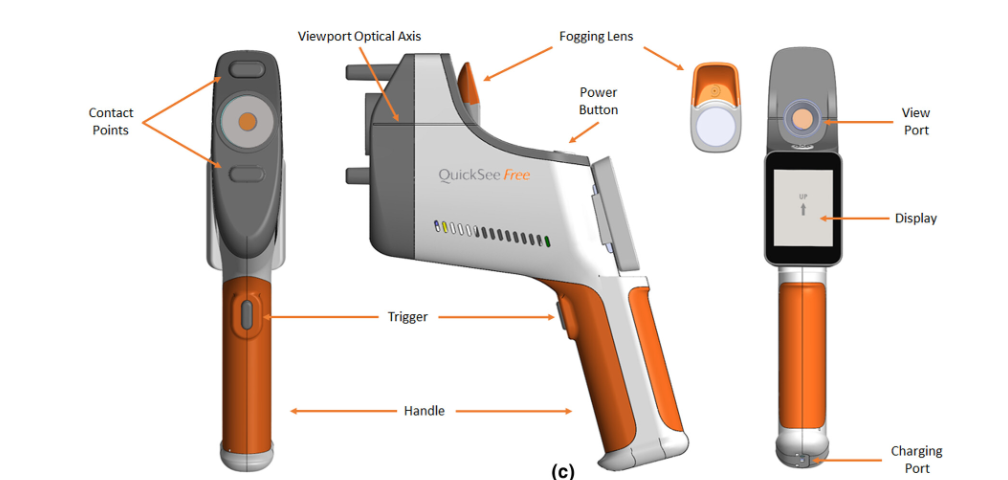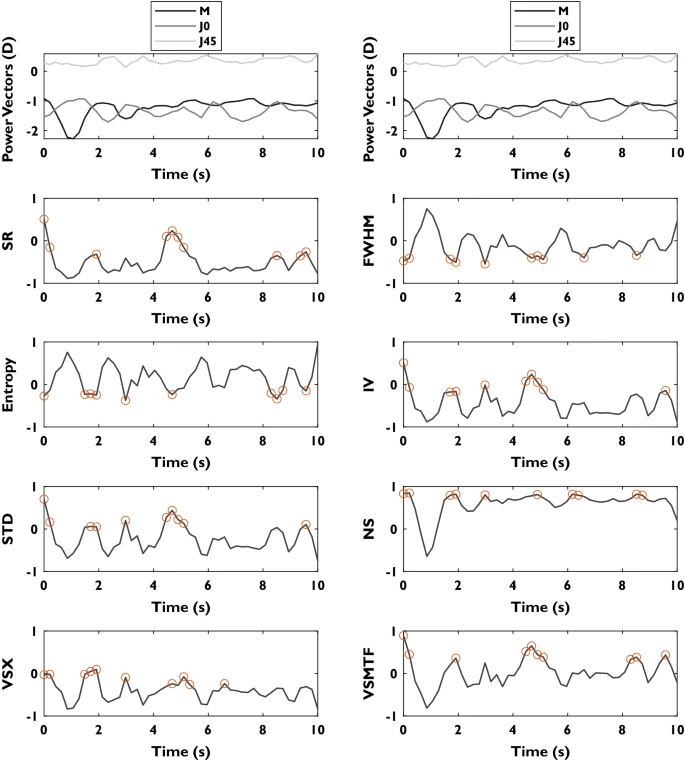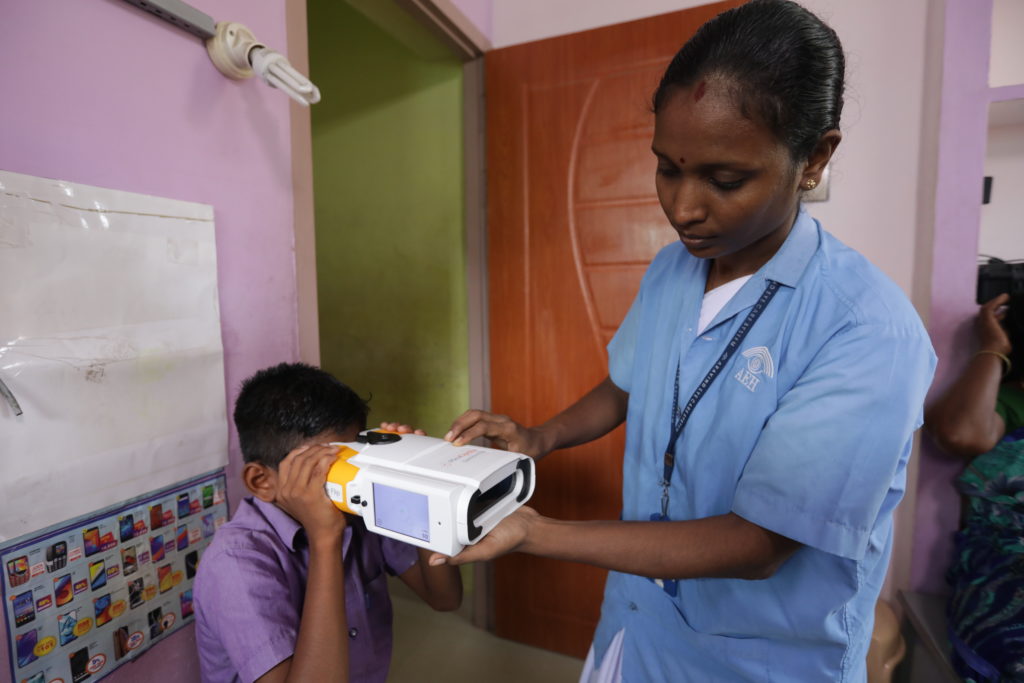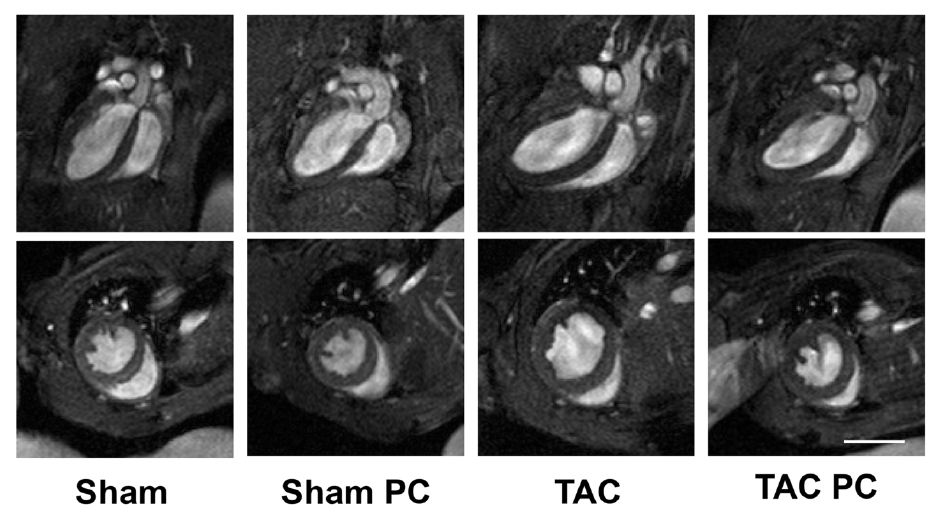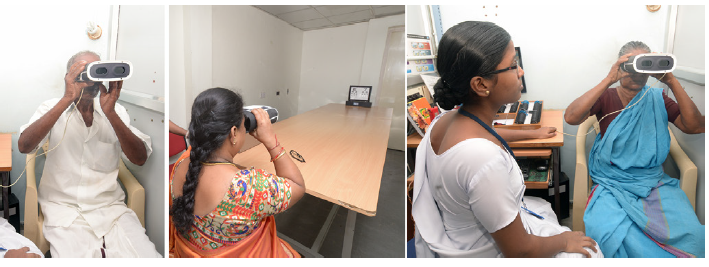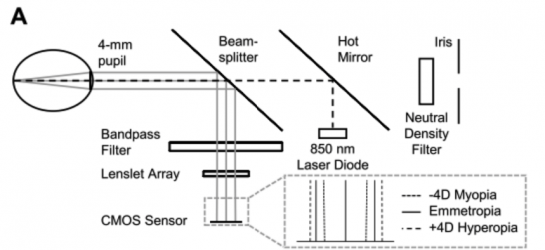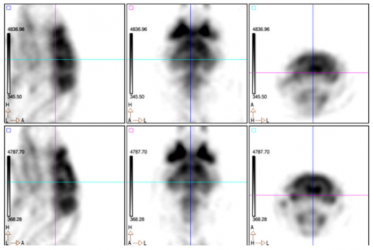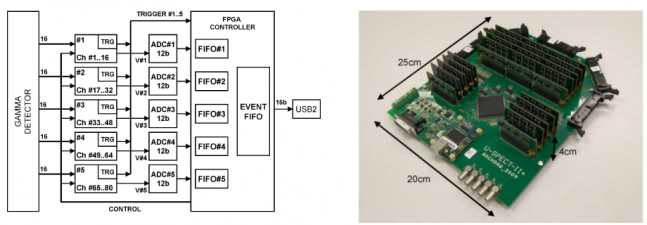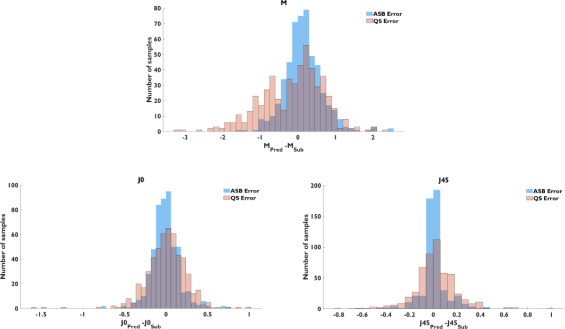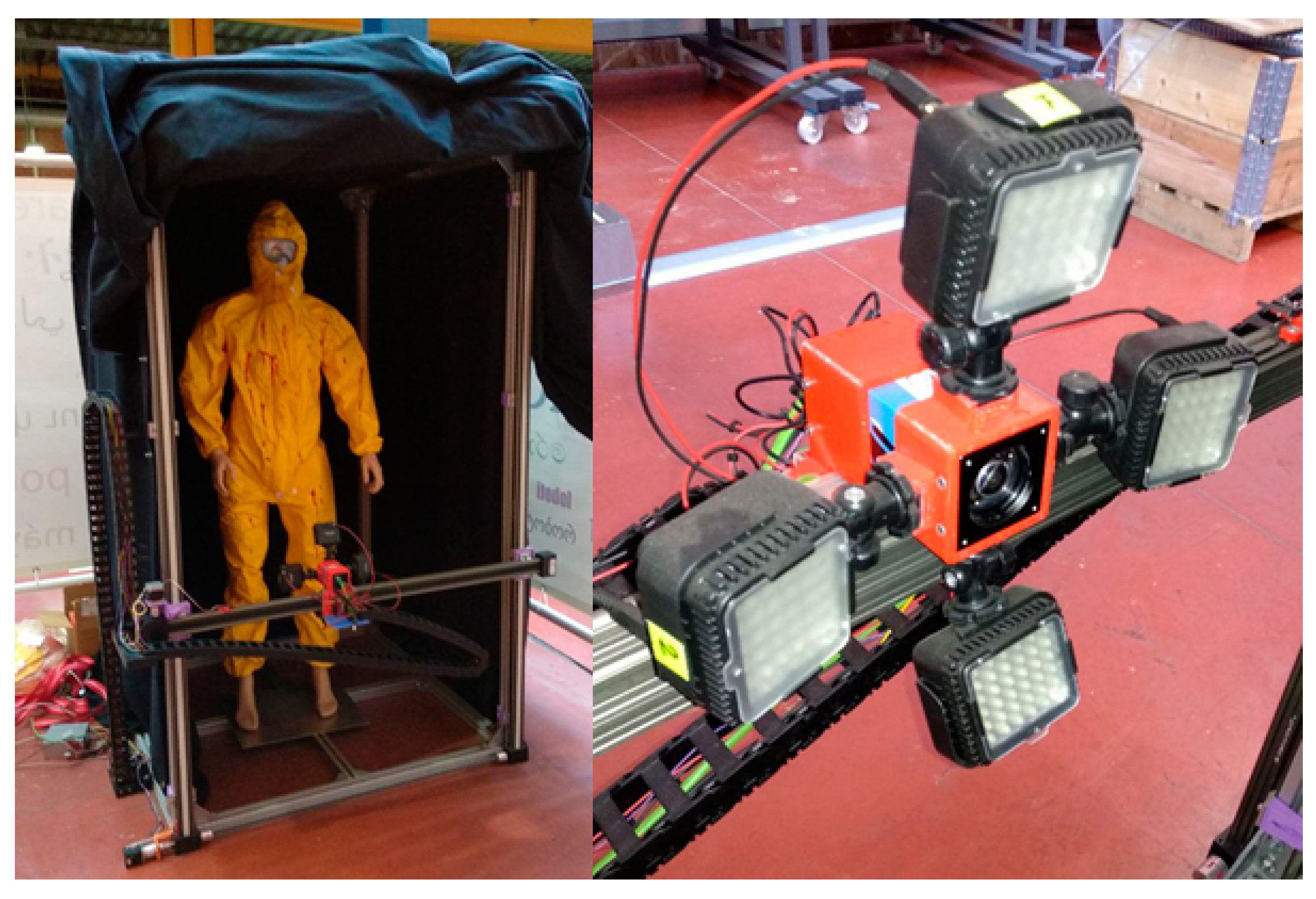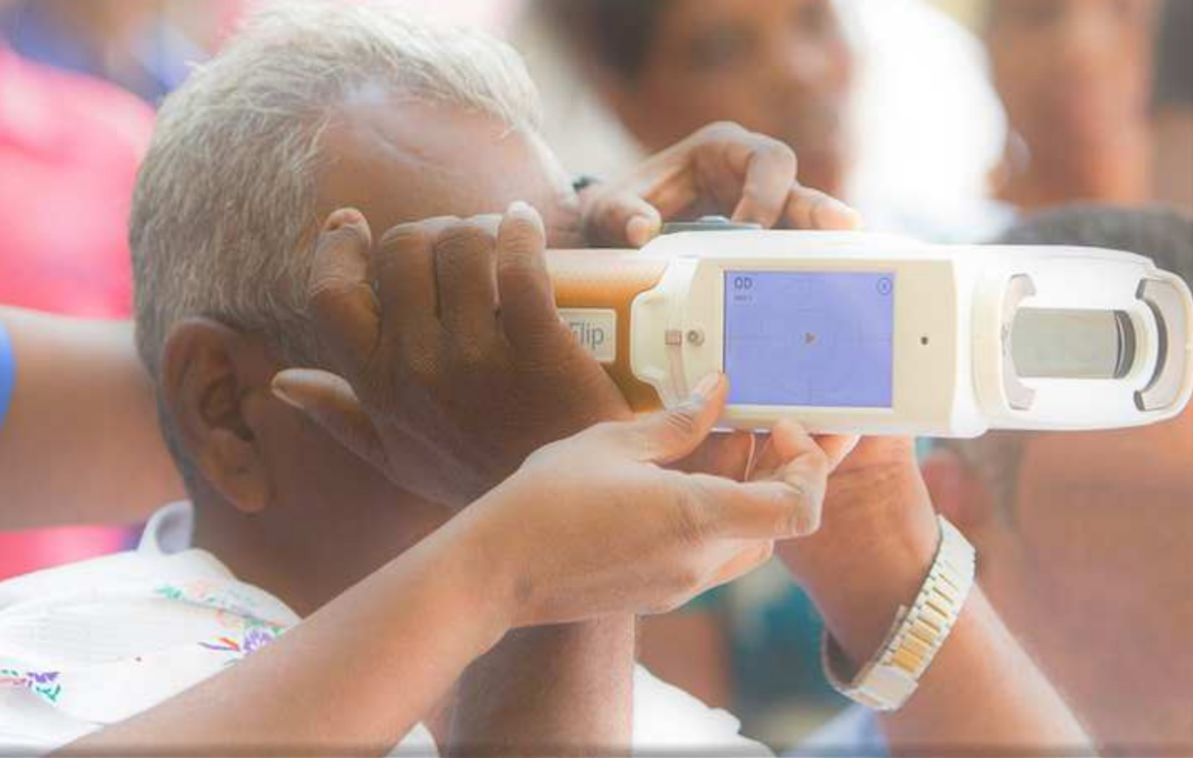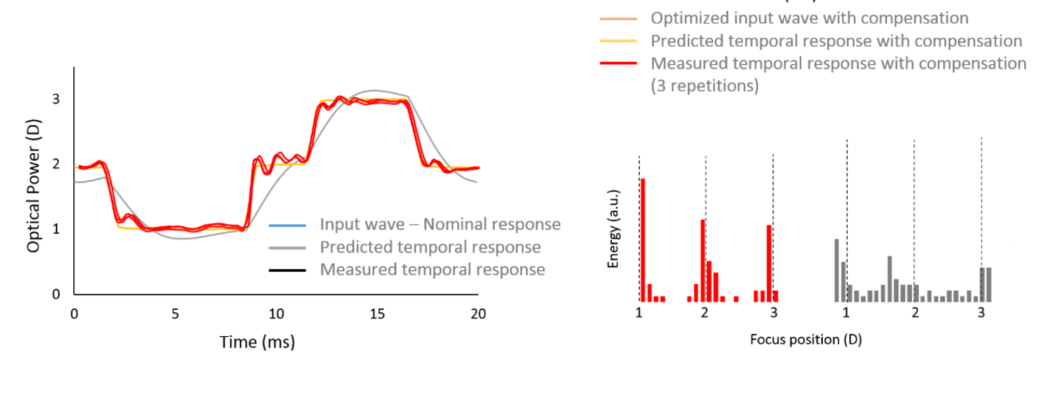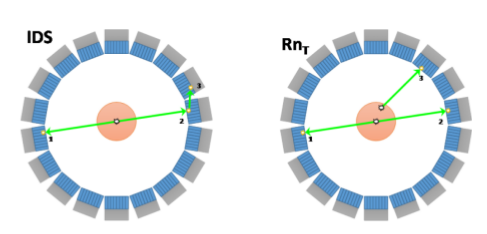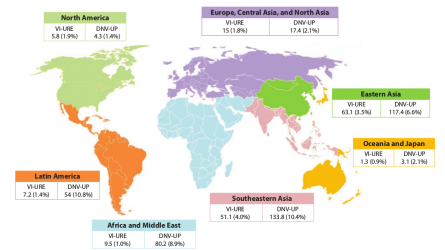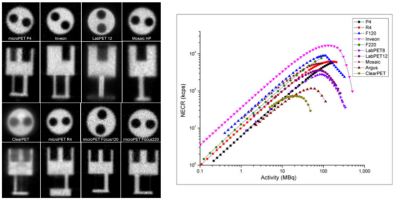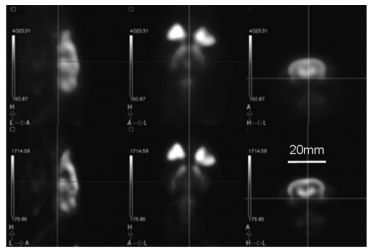| AUTHORS | |
| JOURNAL | Ophthalmic and Physiological Optics |
| ABSTRACT |
AbstractIntroductionDespite the well-known reproducibility issues of subjective refraction, most studies evaluating autorefractors compared differences between the device and subjective refraction. This work evaluated the performance of a novel handheld Hartmann–Shack-based autorefractor using an alternative protocol, which considered the inherent variability of subjective refraction. MethodsParticipants underwent an initial measurement with a desktop autorefractor, two subjective refractions (SR1 and SR2) and a final measurement with the QuickSee Free (QSFree) portable autorefractor. Autorefractor performance was evaluated by comparing the differences between the QSFree and each of the subjective refractions with the difference between the subjective refractions (SR1 vs. SR2) using Bland–Altman analysis and percentage of agreement. ResultsA total of 75 subjects (53 ± 14 years) were enrolled in the study. The average difference in the absolute spherical equivalent (M) between the QSFree and the SR1 and SR2 was ±0.24 and ±0.02 D, respectively, that is, very similar or smaller than the SR1 versus SR2 difference (±0.26 D). Average differences in astigmatic components were found to be negligible. The results demonstrate that differences between QSFree and both subjective refractions in J0 and J45 were within ±0.50 D for at least 96% of the measurements. The limits of agreement (LOAs) of the differences between QSFree and SR1, as well as QSFree and SR2, were higher than those observed between SR1 and SR2 for M, J0 and J45. ConclusionsA protocol was designed and validated for the evaluation of a refractive device to account for the variability of subjective refraction. This protocol was used to evaluate a novel portable autorefractor and observed a smaller difference between the device and subjective refractions than the difference between the two subjective refraction measurements in terms of mean bias error, although the standard deviation was higher.
|
| LINK | here |
| AUTHORS |
Andrea Gil
Carlos S. Hernandez
Ahhyun Stephanie Nam
Varshini Varadaraj
Nicholas J. Durr
Daryl Lim
Shivang R. Dave
Eduardo Lage
|
| JOURNAL | Scientific Reports |
| ABSTRACT |
The aim of this work is to evaluate the performance of a novel algorithm that combines dynamic wavefront aberrometry data and descriptors of the retinal image quality from objective autorefractor measurements to predict subjective refraction. We conducted a retrospective study of the prediction accuracy and precision of the novel algorithm compared to standard search-based retinal image quality optimization algorithms. Dynamic measurements from 34 adult patients were taken with a handheld wavefront autorefractor and static data was obtained with a high-end desktop wavefront aberrometer. The search-based algorithms did not significantly improve the results of the desktop system, while the dynamic approach was able to simultaneously reduce the standard deviation (up to a 15% for reduction of spherical equivalent power) and the mean bias error of the predictions (up to 80% reduction of spherical equivalent power) for the handheld aberrometer. These results suggest that dynamic retinal image analysis can substantially improve the accuracy and precision of the portable wavefront autorefractor relative to subjective refraction. |
| LINK | here |
| AUTHORS |
Andrea Gil
Carlos S. Hernández
Pablo Pérez-Merino
Marcos Rubio
Gonzalo Velarde
María Abellanas-Lodares
Ángeles Román-Daza
Nicolás Alejandre
Ignacio Jiménez-Alfaro
Ignacio Casares
Shivang R. Dave
Daryl Lim
Eduardo Lage
|
| JOURNAL | PLoS ONE 15(10): e0240933 |
| ABSTRACT |
ABSTRACT Purpose Methods Results Conclusions |
| LINK | here |
| AUTHORS |
Maria Tamayo
Laura Martin-Nunes
Almudena Val-Blasco
Maria Jose G.M-Piedras
Jose Alberto Navarro-Garcia
Eduardo Lage
Patricia Prieto
Gema Ruiz-Hurtado
Maria Fernandez-Velasco
Carmen Delgado
|
| JOURNAL | British Journal of Pharmacology Vol 177(14), 3273-3290 |
| ABSTRACT |
Background and PurposeThe synthetic vitamin D3 analogue paricalcitol acts as a selective activator of the vitamin D receptor (VDR). While there is evidence for cardioprotective effects of paricalcitol associated with the VDR pathway, less information is available about the structural and functional cardiac effects of paricalcitol on established heart failure (HF) and particularly its effects on associated electrophysiological or Ca2+ handling remodelling. Experimental ApproachWe used a murine model of transverse aortic constriction (TAC) to study the effect of paricalcitol on established HF. Treatment was initiated 4 weeks after surgery over five consecutive weeks, and mice were sacrificed 9 weeks after surgery. Cardiac MRI (CMRI) was performed 4 and 9 weeks after surgery. Hearts were used for biochemical and histological studies and to isolate ventricular myocytes for electrophysiological and calcium imaging studies. |
| AUTHORS |
Nicholas J Durr
Shivang R Dave
Daryl Lim
Sanil Joseph
Thulasiraj D Ravilla
Eduardo Lage
|
| JOURNAL | BMJ open Ophthalmology 2019;4: e000225 |
| ABSTRACT | Objective: To assess the quality of eyeglass prescriptions provided by an affordable wavefront autorefractor operated by a minimally trained technician in a low-resource setting. Methods and Analysis 708 participants were recruited from consecutive patients registered for routine eye examinations at Aravind Eye Hospital in Madurai, India, or an affiliated rural satellite vision centre. Visual acuity (VA) and patient preference were compared between trial lenses set to two eyeglass prescriptions from (1) a novel wavefront autorefractor and (2) subjective refraction by an experienced refractionist. |
| AUTHORS |
Nicholas J. Durr
Shivang R. Dave
Fuensanta A. Vera Diaz
DAryl Lim
Carlos Dorronsoro
Susana Marcos
Frank Thorn
Eduardo Lage
|
| JOURNAL | Optometry and Vision Science, Vol 92, No 12, 2015 |
| ABSTRACT | Purpose. To introduce a novel autorefractor design that is intended to be manufacturable at low cost and evaluate its performance in measuring refractive errors. Methods. We developed a handheld, open-view autorefractor (the ͚͚QuickSee͛͛ [QS]) that uses a simplified approach to wavefront sensing that forgoes moving parts and expensive components |
| AUTHORS |
J Cal-González
E Lage
E Herranz
E Vicente
J M Udias
S C Moore
M-A Park
S R Dave
V Parot
J L Herraiz
|
| JOURNAL | Physics in Medicine & Biology, Vol 60, No 1, December 2014 |
| ABSTRACT | Although current PET scanners are designed and optimized to detect double coincidence events, there is a significant amount of triple coincidences in any PET acquisition. Triple coincidences may arise from causes such as: interdetector scatter (IDS), random triple interactions (R T ), or the detection of prompt gamma rays in coincidence with annihilation photons when non-pure positron-emitting radionuclides are used (β + γ events). Depending on the data acquisition settings of the PET scanner, these triple events are discarded or processed as a set of double coincidences if the energy of the three detected events is within the scanner’s energy window. This latter option introduces noise in the data, as at most, only one of the possible lines-of-response defined by triple interactions corresponds to the line along which the decay occurred. |
| AUTHORS |
M Abella
E Vicente
A Rodrı́guez-Ruano
S España
E Lage
M Desco
J M Udias
J J Vaquero
|
| JOURNAL | Physics in Medicine & Biology, Vol 57,No 22, September 2012 |
| ABSTRACT | Technological advances have improved the assembly process of PET detectors, resulting in quite small mechanical tolerances. However, in high-spatial-resolution systems, even submillimetric misalignments of the detectors may lead to a notable degradation of image resolution and artifacts. Therefore, the exact characterization of misalignments is critical for optimum reconstruction quality in such systems. This subject has been widely studied for CT and SPECT scanners based on cone beam geometry, but this is not the case for PET tomographs based on rotating planar detectors. The purpose of this work is to analyze misalignment effects in these systems and to propose a robust and easy-to-implement protocol for geometric characterization. The result of the proposed calibration method, which requires no more than a simple calibration phantom, can then be used to generate a correct 3D-sinogram from the acquired list mode data. |
| LINK | http://iopscience.iop.org |
| AUTHORS |
G. Tapias
J. L. Villena
R. Kreuger
E. Lage
F. J. Beekman
|
| JOURNAL | IEEE TRANSACTIONS ON NUCLEAR SCIENCE, VOL. 59, NO. 3, JUNE 2012 |
| ABSTRACT | We have developed an 80-channel readout system for gamma cameras which acquires PMT signals and stores them in list-mode format on a computer. The system combines low noise and a large signal range to handle PMT signals from a wide range of SPECT and PET tracers simultaneously (27 to 511 keV).
All channels of the read-out system have a gated integrator to determine the charge per event. Each 16 channels are multiplexed to a 12-bit 40 MS/s pipelined ADCs. Using multiplexing only 5 ADCs are needed which share a commercial USB 2.0 interface board to send the event data to the computer. |
| AUTHORS |
Eduardo Lage
José L. Villena
Gustavo Tapias
Naira P. Martínez
Maria L. Soto-Montenegro
Mónica Abella
Alejandro Sisniega
Francisco Pino
Domènec Ros
Javier Pavía
Manuel Desco
Juan J. Vaquero
|
| JOURNAL | IEEE TRANSACTIONS ON NUCLEAR SCIENCE, VOL. 57, NO. 5, OCTOBER 2010 |
| ABSTRACT | We developed a cost-effective SPECT scanner prototype (rSPECT) for in vivo imaging of rodents based on small-area gamma cameras. Each detector consists of a position-sensitive photomultiplier tube (PS-PMT) coupled to a 30 x 30 Nal(Tl) scintillator array and electronics attached to the PS-PMT sockets for adapting the detector signals to an in-house developed data acquisition system. The detector components are enclosed in a lead-shielded case with a receptacle to insert the collimators. |
| AUTHORS |
E Lage
J J Vaquero
A Sisniega
S España
G Tapias
M Abella
A Rodrı́guez-Ruano J E Ortuño
A Udı́as
M Desco
|
| JOURNAL | Physics in Medicine & Biology, Vol. 54, No. 18 |
| ABSTRACT | This work reports on the development and performance evaluation of the VrPET/CT, a new multimodality scanner with coplanar geometry for in vivo rodent imaging. The scanner design is based on a partial-ring PET system and a small-animal CT assembled on a rotatory gantry without axial displacement between the geometric centers of both fields of view (FOV). We report on the PET system performance based on the NEMA NU-4 protocol; the performance characteristics of the CT component are not included herein. The accuracy of inter-modality alignment and the imaging capability of the whole system are also evaluated on phantom and animal studies. |
| AUTHORS |
J. J. Vaquero
S. Redondo
E. Lage
M. Abella
A. Sisniega
G. Tapias
M. L. Soto Montenegro
M. Desco
|
| JOURNAL | IEEE TRANSACTIONS ON NUCLEAR SCIENCE, VOL. 55, NO. 3, JUNE 2008 |
| ABSTRACT | We have developed a new X-ray cone-beam tomograph for in vivo small-animal imaging using a flat panel detector (CMOS technology with a microcolumnar CsI scintillator plate) and a microfocus X-ray source. The geometrical configuration was designed to achieve a spatial resolution of about 12 lpmm with a field of view appropriate for laboratory rodents. In order to achieve high performance with regard to per-animal screening time and cost, the acquisition software takes advantage of the highest frame rate of the detector and performs on-the-fly corrections on the detector raw data. These corrections include geometrical misalignments, sensor non-uniformities, and defective elements. The resulting image is then converted to attenuation values. We measured detector modulation transfer function (MTF), detector stability, system resolution, quality of the reconstructed tomographic images and radiated dose. |
| AUTHORS |
Carlos S. Hernandez
Andrea Gil
Ignacio Casares
Jesus Poderoso
Alec Wehse
Shivang R. Dave
Daryl Lim
Manuel Sanchez-Montañes
Eduardo Lage
|
| JOURNAL | Journal of Optometry |
| ABSTRACT |
PurposeTo assess the performance of machine learning (ML) ensemble models for predicting patient subjective refraction (SR) using demographic factors, wavefront aberrometry data, and measurement quality related metrics taken with a low-cost portable autorefractor. MethodsFour ensemble models were evaluated for predicting individual power vectors (M, J0, and J45) corresponding to the eyeglass prescription of each patient. Those models were random forest regressor (RF), gradient boosting regressor (GB), extreme gradient boosting regressor (XGB), and a custom assembly model (ASB) that averages the first three models. Algorithms were trained on a dataset of 1244 samples and the predictive power was evaluated with 518 unseen samples. Variables used for the prediction were age, gender, Zernike coefficients up to 5th order, and pupil related metrics provided by the autorefractor. Agreement with SR was measured using Bland-Altman analysis, overall prediction error, and percentage of agreement between the ML predictions and subjective refractions for different thresholds (0.25 D, 0.5 D). ResultsAll models considerably outperformed the predictions from the autorefractor, while ASB obtained the best results. The accuracy of the predictions for each individual power vector component was substantially improved resulting in a ± 0.63 D, ±0.14D, and ±0.08 D reduction in the 95% limits of agreement of the error distribution for M, J0, and J45, respectively. The wavefront-aberrometry related variables had the biggest impact on the prediction, while demographic and measurement quality-related features showed a heterogeneous but consistent predictive value. ConclusionsThese results suggest that ML is effective for improving precision in predicting patient’s SR from objective measurements taken with a low-cost portable device. |
| LINK | here |
| AUTHORS |
Sanil Joseph, MHA, MSc
Varshini Varadaraj, MD, MPH
Shivang R. Dave, PhD
Eduardo Lage, PhD
Daryl Lim, PhD
Kanza Aziz, MD
Sarah Dudgeon, (MPH)
Thulasiraj D. Ravilla, MBA
David S. Friedman, MD, PhD, MPH
|
| JOURNAL | Ophthalmology |
| ABSTRACT |
AbstractPurpose To compare patient preferences for eye glasses prescribed using a low-cost portable wavefront autorefractor versus standard subjective refraction.
Design Randomized, cross-over clinical trial
Participants Patients aged 18-40 years presenting with refractive errors to a tertiary eye hospital in Southern India.
Methods Participants underwent subjective refraction (SR) followed by autorefraction (AR) using the monocular version of the QuickSee device. An independent optician, masked to the refraction approach, prepared eyeglasses based on each refraction approach. Participants (masked-to-refraction source) were randomly assigned to use either SR- or AR-based eyeglasses first, followed by the other pair, for a week each. At the end of each week, participants had vision checked and were interviewed about their experience with the eyeglasses.
Main outcome measures Proportion of patients preferring eyeglasses prescribed using AR and SR
Results The 400 participants enrolled between March 26, 2018 and August 02, 2019, had mean (SD) age of 28.4 (6.6) years and 68.8% were women. There was strong correlation between spherical equivalents using SR and AR (r=0.97, p<0.001) with a mean difference of -0.07 diopters (95% limits of agreement: -0.68 to 0.83). Of the 301 (75.2%) patients who completed both follow-up visits, 50.5% (n=152) and 49.5% (n=149) preferred glasses prescribed using SR and AR, respectively (95% CI: 45.7% – 56.3%; p=0.86). There were no differences in demographic or vision characteristics between participants with different preferences (p>0.05 for all).
Conclusions We observed strong agreement between the prescriptions from SR and QR, and eyeglasses prescribed using SR and AR were equally preferred by patients. Wider use of prescribing based on AR alone in resource-limited settings is supported by these findings.
|
| LINK | here |
| AUTHORS | |
| JOURNAL | Special Issue “Applied Intelligent Control and Perception in Robotics and Automation” |
| ABSTRACT |
The inspection of Personal Protective Equipment (PPE) is one of the most necessary measures when treating patients affected by infectious diseases, such as Ebola or COVID-19. Assuring the integrity of health personnel in contact with infected patients has become an important concern in developed countries. This work focuses on the study of Reinforcement Learning (RL) techniques for controlling a scanner prototype in the presence of blood traces on the PPE that could arise after contact with pathological patients. A preliminary study on the design of an agent-environment system able to simulate the required task is presented. The task has been adapted to an environment for the OpenAI Gym toolkit. The evaluation of the agent’s performance has considered the effects of different topological designs and tuning hyperparameters of the Q-Learning model-free algorithm. Results have been evaluated on the basis of average reward and timesteps per episode. The sample-average method applied to the learning rate parameter, as well as a specific epsilon decaying method worked best for the trained agents. The obtained results report promising outcomes of an inspection system able to center and magnify contaminants in the real scanner system. |
| AUTHORS |
Marcos Rubio
Carlos S. Hernandez
Enrique Seco
Pablo Perez-Merino
Ignacio Casares
Shivang R Dave
Daryl Lim
Nicholas J Durr
Eduardo Lage
|
| JOURNAL | Optometry and Vision Science 2019, Vol 96(10), 726-732 |
| ABSTRACT | Significance: There is a critical need for tools that increase the accessibility of eye care to address the most common cause of vision impairment: uncorrected refractive errors. This work assesses the performance of an affordable autorefractor which could help reduce the burden of this healthcare problem in low-resource communities.
Purpose. To validate the commercial version of portable wavefront autorefractor for measuring refractive errors. |
| AUTHORS |
Carlos Dorronsoro
Xoana Barcala
Enrique Gambra
Vyas Akondi
Lucie Sawides
Yassine Marrackchi
Victor Rodriguez-Lopez
Clara Benedi-Garcia
Maria Viñas
Eduardo Lage
Susana Marcos
|
| JOURNAL | Optics Express vol 27 Issue 3, 2085-100, 2019 |
| ABSTRACT | Tunable lenses are becoming ubiquitous, in applications including microscopy, optical coherence tomography, computer vision, quality control, autorefractors, and presbyopic corrections. Many applications require an accurate control of the optical power of the lens in response to a time-dependent input waveform. |
| AUTHORS |
Eduardo Lage
Vicente Parot
Stephen C. Moore
Arkadiusz Sitek
Jose M. Udías
Shivang R. Dave
Mi-Ae Park
Juan J. Vaquero
Joaquin L. Herraiz
|
| JOURNAL | Medical Physics, Vol 42, No 3, March 2015 |
| ABSTRACT | Purpose: Triple coincidences in positron emission tomography (PET) are events in which three γ-rays are detected simultaneously. These events, though potentially useful for enhancing the sensi- tivity of PET scanners, are discarded or processed without special consideration in current systems, because there is not a clear criterion for assigning them to a unique line-of-response (LOR). Methods proposed for recovering such events usually rely on the use of highly specialized detection systems, hampering general adoption, and/or are based on Compton-scatter kinematics and, consequently, are limited in accuracy by the energy resolution of standard PET detectors. In this work, the authors propose a simple and general solution for recovering triple coincidences, which does not require specialized detectors or additional energy resolution requirements. |
| AUTHORS |
Nicholas J. Durr
Shivang R. Dave
Eduardo Lage
Susana Marcos
Frank Thorn
Daryl Lim
|
| JOURNAL | Annual Review of Biomedical Engineering, Vol 16, July 2014 |
| ABSTRACT | Worldwide, more than one billion people suffer from poor vision because they do not have the eyeglasses they need. Their uncorrected refractive errors are a major cause of global disability and drastically reduce productivity, educational opportunities, and overall quality of life. The problem persists most prevalently in low-resource settings, even though prescription eyeglasses serve as a simple, effective, and largely affordable solution. In this review, we discuss barriers to obtaining, and approaches for providing, refractive eye care. We also highlight emerging technologies that are being developed to increase the accessibility of eye care. Finally, we describe opportunities that exist for engineers to develop new solutions to positively impact the diagnosis and treatment of correctable refractive errors in low-resource settings. |
| LINK | https://www.annualreviews.org/ |
| AUTHORS |
Andrew L. Goertzen
Qinan Bao
Mélanie Bergeron
Eric Blankemeyer
Stephan Blinder
Mario Cañadas
Arion F. Chatziioannou
Katherine Dinelle
Esmat Elhami
Hans-Sonke Jans
Eduardo Lage
Roger Lecomte
Vesna Sossi
Suleman Surti
Yuan-Chuan Tai
Juan José VaqueroEsther Vicente
Darin A. Williams
Richard Laforest
|
| JOURNAL | Journal of Nuclear Medicine, vol. 53, n. 8, aug. 2012. Pp. 1-10 |
| ABSTRACT | Purpose: The National Electrical Manufacturers Association (NEMA) standard NU 4-2008 for performance measurements of small-animal tomographs was recently published. Before this standard, there were no standard testing procedures for preclinical PET systems, and manufacturers could not provide clear specifications similar to those available for clinical systems under NEMA NU 2-1994 and 2-2001. Consequently, performance evaluation papers used methods that were modified adhoc from the clinical PET NEMA standard, thus making comparisons between systems difficult. |
| AUTHORS |
Mario Cañadas
Miguel Embid
Eduardo Lage
Manuel Desco,
Juan José Vaquero José Manuel Pérez
|
| JOURNAL | IEEE TRANSACTIONS ON NUCLEAR SCIENCE, VOL. 58, NO. 1, FEBRUARY 2011 |
| ABSTRACT | In this work, we compare two commercial positron emission tomography (PET) scanners installed at CIEMAT (Madrid, Spain): the ClearPET and the rPET-1. These systems have significant geometrical differences, such as the axial field of view (110 mm on ClearPET versus 45.6 mm on rPET-1), the configuration of the detectors (whole ring on ClearPET versus one pair of planar blocks on rPET-1) and the use of an axial shift between ClearPET detector modules. We used an assessment procedure that fulfilled the recommendations of the National Electrical Manufacturers Association (NEMA) NU 4-2008 standard. The methodology includes studies of spatial resolution, sensitivity, scatter fraction, count losses and image quality. |
| AUTHORS |
E Lage
G Tapias
J Villena
M Desco
J J Vaquero
|
| JOURNAL | Physics in Medicine & Biology, Vol. 55, No 15, July 2010 |
| ABSTRACT | We present a new high-performance and low-cost approach for implementing radiation detection acquisition systems. The basic elements used are charge-integrating ADCs and a set of components encapsulated in an HDL (hardware definition language) library which makes it possible to implement several acquisition tasks such as time pickoff and coincidence detection using a new and simple trigger technique that we name WMLET (width-modulated leading-edge timing). As proof of concept, a 32-channel hybrid PET/SPECT acquisition system based on these elements was developed and tested. This demonstrator consists of a master module responsible for the generation and distribution of trigger signals, 2 × 16-channel ADC cards (12-bit resolution) for data digitization and a 32-bit digital I/O PCI card for handling data transmission to a personal computer. |
| AUTHORS |
M. Abella
J. J. Vaquero
M. L. Soto-Montenegro E. Lage M. Desco |
| JOURNAL | Medical Physics, Volume 36, Issue 5, May 2009 |
| ABSTRACT | Low-pass filtering of sinograms in the radial direction is the most common practice to limit noise amplification in filtered back projection (FBP) reconstruction of positron emission tomography studies. Other filtering strategies have been proposed to prevent the loss in resolution due to low-pass radial filters, although results have been diverse. Using the well-known properties of the Fourier transform of a sinogram, the authors defined a binary mask that matches the expected shape of the support region in the Fourier domain of the sinogram (“bow tie”). This mask was smoothed by a convolution with a ten-point Gaussian kernel which not only avoids ringing but also introduces a pre-emphasis at low frequencies. A new filtering scheme for FBP is proposed, comprising this smoothed bow-tie filter combined with a standard radial filter and an axial filter. The authors compared the performance of the bow-tie filtering scheme with that of other previously reported methods: Standard radial filtering, angular filtering, and stackgram-domain filtering. |



